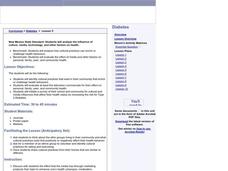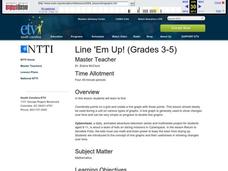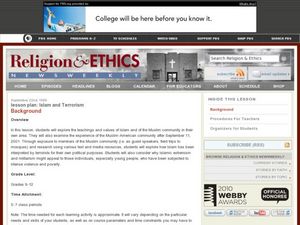Curated OER
What's the Big Deal?
Young scholars explore and define methane hydrates and describe ways that it can impact their own lives. In this methane hydrate lesson plan students create a molecular model and research methane hydrate.
Curated OER
Let's Go to the Video Tape!
Students examine biological diversity and see how it relates to the concepts of variety and relative abundance. In this investigative lesson students view a video on biodiversity and complete an activity.
Curated OER
Looking for Clues
Students infer the cause of a shipwreck based upon information about artifacts found in the wreck. In this marine archeology lesson, students use an inventory list to infer the cause of a shipwreck. Students discuss the maritime...
Curated OER
What's Eating Your Ship?
Students examine the processes that contribute to the deterioration of shipwrecked in shallow and deep water. In this research instructional activity students explore shipwrecks and how the deterioration process works. ...
Curated OER
Giants of the Protozoa
Students describe and define xenophyophores. In this protozoa lesson students divide into groups and complete a lab activity.
Curated OER
Podcasting: Sharing Your Ideas About Featured Topics and Issues
Students investigate podcasting. They read an article related to podcasting. Students access a podcast and using various features such as pausing, rewinding, and fast-forwarding. They work in small groups to produce an original...
Curated OER
Diabetes
Students identify community cultural practices that enrich or challenge health behaviors. Students evaluate television commercials for their effects on health and initiate a survey of cultural and media influences that might affect health.
Curated OER
Cloud in the Classroom
Students describe the relationship between animals and humans. For this biology lesson, students research about the history of horses in America. They present a mock news broadcast about their research.
Curated OER
Battery Power
Sixth graders examine how much energy they use in the form of battery power. They examine the cost of using regular vs. rechargeable batteries and examine the effect on the environment of the two types of batteries. They discover that...
Curated OER
Dreaming to Come to America
Students examine reasons for immigration to America, including economic, political, and religious considerations, and conduct research to determine immigration history of students' families and compare reasons other groups have come to...
Curated OER
Teams in the Field
Students conduct team interviews outside the classroom, either within the school or beyond, as part of a fieldwork project. They use reasoning skills as they formulate questions, plan, predict, hypothesize, and speculate about the...
Curated OER
Ecological Footprint
Eighth graders discover their own ecological footprint and create a plan for reducing this figure. They extend this to the school and community to see how they are doing on this scale. They discuss the concept of the ecological...
Curated OER
Woody Guthrie: Ain't Got No Home
Students examine the music of Woody Guthrie and how the political and economic climate influenced his work. They read and discuss online articles, define key vocabulary words, take a Political Orientation Survey, and write a position...
Curated OER
Working to Overcome Stereotyping
Learners design and conduct a survey to develop an understanding of the challenges inherent in changing attitudes and overcoming stereotypes about the Muslim religion and culture. They create multimedia presentations of the findings.
Curated OER
Line 'Em Up!
Young scholars find coordinate points on a grid and create a line graph with those points. This lesson should ideally be used during a unit on various types of graphs. They make and use coordinate systems to specify locations and to...
Curated OER
Exploring 9/11 in Historical, Cultural and International Context: Why Here, Why Us, Why Now?
Students examine the international conflicts that might have caused the terrorist attacks of 9/11. In groups, they research the similarities and differences between the three major religions and how they connect to 9/11. To end the...
Curated OER
Islam and Terrorism
Students explore Muslim beliefs. In this Muslim extremist lesson, students research Internet and print sources regarding Muslim beliefs and examine how Muslim extremists have interpreted the tenets of the religion to advance their...
Curated OER
My Hero Learning Circle
Students participate in a collaboration activity. In this My Hero Project instructional activity, students discover what a hero is to someone halfway around the world and themselves. Over the 16-week session, circles, made up of between...
Curated OER
When Building Up Leads to Breaking Down
Students examine where one develops his or her views about health and ways in which teen-agers exhibit these influences, focusing particularly on the rising trend of anabolic steroid use in teen-age girls.
Curated OER
Ellis Island: Gateway To America
Fifth graders study the immigration station on Ellis Island. Through several activities, they see that immigrants who arrived at Ellis Island came to America from different countries, mostly those in Europe, for a variety of reasons.
Curated OER
Looking for More Clues
Fifth graders explore how to collect data and display it on a bar and circle graph.
Curated OER
Identifying Anger Triggers
Students, while in the computer lab on Inspiration, visit angermgmt.com and then brainstorm additional anger triggers on a concept map together in groups. Once completed, they identify two new anger management strategies to try out in...
Curated OER
Twisting Versions of Little Red Riding Hood
Students read orally two versions of Little Red Riding Hood (Classic and Cajun) They compare and contrast the two Little Red Riding Hood versions. Students create a concept map to demonstrate the comparisons/contrasts. They could also...
Curated OER
How Long? How Wide?
Second graders distinguish between and use nonstandard and standard units of measurement, use appropriate tools and techniques to measure length and width, and record and interpret data using graphs.























